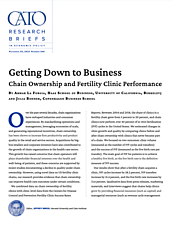Over the past several decades, chain organizations have reshaped industries and consumer experiences. By standardizing operations and management, leveraging economies of scale, and generating reputational incentives, chain ownership has been shown to increase firm productivity and product quality in the retail and service sectors. Acquisitions by big-box retailers and corporate investors have also contributed to the growth of chain organizations in the health care sector. This growth has raised concerns that chain operators will place shareholder financial interests over the health and well-being of patients, and these concerns are supported by recent studies documenting a decline in quality under chain ownership. However, using novel data on US fertility clinic chains, our research provides evidence that chain ownership can improve health care outcomes under certain conditions.
We combined data on chain ownership of fertility clinics with clinic-level data from the Centers for Disease Control and Prevention Fertility Clinic Success Rates Reports. Between 2004 and 2018, the share of clinics in a fertility chain grew from 5 percent to 20 percent, and chain clinics now perform over 40 percent of in vitro fertilization (IVF) cycles in the United States. We estimated changes in clinic growth and quality by comparing clinics before and after chain ownership with clinics that never became part of a chain. We focused on two outcomes: clinic volume (measured as the number of IVF cycles and transfers) and the success of IVF (measured as the live birth rate per transfer). The main goal of IVF for patients is to achieve a healthy live birth, so the live birth rate is the definitive measure of IVF success.
Our results show that after a fertility chain acquires a clinic, IVF cycles increase by 28.2 percent, IVF transfers increase by 21.4 percent, and the live birth rate increases by 13.6 percent. Qualitative data from press releases, marketing materials, and interviews suggest that chains help clinics grow by providing financial resources (such as capital) and managerial resources (such as revenue cycle management and marketing services). These data also suggest that chains help improve quality by implementing best practices, protocols, and training and by facilitating knowledge sharing between clinics through research consortiums and complex case review meetings.
As with other chain organizations, some transactions are acquisitions, where the fertility chain’s parent company owns the clinic’s assets, while other transactions are affiliations, where a clinic contracts with a fertility chain for management services and access to capital. In an acquisition, the chain has greater control over clinical processes, whereas in an affiliation clinic owners retain greater decisionmaking authority. Our research shows that clinics acquired by chains, but not clinics only affiliated with chains, improve IVF success rates, and it finds that both acquired and affiliated clinics increase volume but that only acquired clinics increase live birth rates. This finding suggests that chain affiliations can facilitate resource transfers necessary to increase volume but may not generate sufficient incentives to invest in quality improvement.
The results also show that chains update clinic processes and procedures in ways that enhance quality and are consistent with new knowledge, leading to improved outcomes. For example, acquired clinics achieve the IVF gold standard: they reduce multiple births, which pose significantly higher risks for patients, and increase singleton births by enough to have a net positive increase in the live birth rate. This result suggests that the quality of IVFs for acquired clinics has been enhanced, as it coincides with acquired clinics reducing the number of embryos placed in the uterus per transfer, suggesting that these clinics improve techniques and processes when conducting single embryo transfers. Acquired clinics also achieve higher IVF success rates among older patients, whose cases are often more complex. One reason for these improvements is that acquired clinics significantly increase preimplantation genetic testing, which can help physicians choose higher-quality embryos.
Our research finds that clinics acquired by higher-quality chains experience larger increases in live birth rates than those acquired by lower-quality chains. Clinics that are initially lower performing also experience larger improvements than initially higher-performing clinics after acquisition by a chain. Furthermore, the data show that clinics with minimal increases in volume still significantly increase the live birth rate, which rules out the possibility that clinics learn via increased volume rather than from the chain.
Our analysis shows that chains expand total clinic operations rather than transfer business from nonchain clinics. Moreover, acquired clinics are twice as likely as nonchain clinics to advertise money-back guarantees or multiple-cycle discounts; such marketing efforts may contribute to market expansion since patients likely view these offers as increasing IVF affordability. Our research also studies private equity investment in fertility chains and finds that the largest increases in clinic volume occur when a fertility chain receives private equity funding.
Overall, our results suggest that fertility chains provide access to new resources and knowledge needed to increase clinic volume and IVF success rates. We investigated whether the improved outcomes resulted from chain clinics selecting younger or healthier patients and found no evidence of this. Our results are similar whether or not we account for patient characteristics and infertility diagnosis, and there are no systematic changes in patient characteristics after chain acquisition that would influence IVF success. Maternal age is the single most important predictor of IVF success, and our research shows that the distribution of patients in younger and older age groups is similar before and after a clinic acquisition. Finally, our results show no evidence that chains systematically acquire clinics that were already improving outcomes, which suggests that acquisitions themselves improve outcomes.
Note:
This research brief is based on Ambar La Forgia and Julia Bodner, “Getting Down to Business: Chain Ownership and Fertility Clinic Performance,” August 2023.

This work is licensed under a Creative Commons Attribution-NonCommercial-ShareAlike 4.0 International License.
